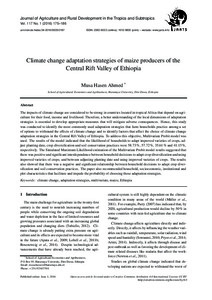Datum
2016-06-01Autor
Ahmed, Musa HasenSchlagwort
630 Landwirtschaft, VeterinärmedizinMetadata
Zur Langanzeige
Aufsatz

Climate change adaptation strategies of maize producers of the Central Rift Valley of Ethiopia
Zusammenfassung
The impacts of climate change are considered to be strong in countries located in tropical Africa that depend on agriculture for their food, income and livelihood. Therefore, a better understanding of the local dimensions of adaptation strategies is essential to develop appropriate measures that will mitigate adverse consequences. Hence, this study was conducted to identify the most commonly used adaptation strategies that farm households practice among a set of options to withstand the effects of climate change and to identify factors that affect the choice of climate change adaptation strategies in the Central Rift Valley of Ethiopia. To address this objective, Multivariate Probit model was used. The results of the model indicated that the likelihood of households to adapt improved varieties of crops, adjust planting date, crop diversification and soil conservation practices were 58.73%, 57.72%, 35.61% and 41.15%, respectively. The Simulated Maximum Likelihood estimation of the Multivariate Probit model results suggested that there was positive and significant interdependence between household decisions to adapt crop diversification and using improved varieties of crops; and between adjusting planting date and using improved varieties of crops. The results also showed that there was a negative and significant relationship between household decisions to adapt crop diversification and soil conservation practices. The paper also recommended household, socioeconomic, institutional and plot characteristics that facilitate and impede the probability of choosing those adaptation strategies.
Zitierform
In: Journal of Agriculture and Rural Development in the Tropics and Subtropics. Kassel : Kassel University Press. - Vol. 117, No. 1 (2016), S. 175-186Sammlung(en)
Vol 117, No 1 (2016) (Journal of Agriculture and Rural Development in the Tropics and Subtropics (JARTS))Zitieren
@article{urn:nbn:de:hebis:34-2016050350187,
author={Ahmed, Musa Hasen},
title={Climate change adaptation strategies of maize producers of the Central Rift Valley of Ethiopia},
year={2016}
}
0500 Oax 0501 Text $btxt$2rdacontent 0502 Computermedien $bc$2rdacarrier 1100 2016$n2016 1500 1/eng 2050 ##0##urn:nbn:de:hebis:34-2016050350187 3000 Ahmed, Musa Hasen 4000 Climate change adaptation strategies of maize producers of the Central Rift Valley of Ethiopia / Ahmed, Musa Hasen 4030 4060 Online-Ressource 4085 ##0##=u http://nbn-resolving.de/urn:nbn:de:hebis:34-2016050350187=x R 4204 \$dAufsatz 4170 7136 ##0##urn:nbn:de:hebis:34-2016050350187
<resource xsi:schemaLocation="http://datacite.org/schema/kernel-2.2 http://schema.datacite.org/meta/kernel-2.2/metadata.xsd"> 2016-06-13T08:43:18Z 2016-06-13T08:43:18Z 2016-06-01 1612-9830 2363-6033 urn:nbn:de:hebis:34-2016050350187 http://hdl.handle.net/123456789/2016050350187 eng Kassel University Press Urheberrechtlich geschützt https://rightsstatements.org/page/InC/1.0/ climate change adaptation strategies multivariate maize Ethiopia 630 Climate change adaptation strategies of maize producers of the Central Rift Valley of Ethiopia Aufsatz The impacts of climate change are considered to be strong in countries located in tropical Africa that depend on agriculture for their food, income and livelihood. Therefore, a better understanding of the local dimensions of adaptation strategies is essential to develop appropriate measures that will mitigate adverse consequences. Hence, this study was conducted to identify the most commonly used adaptation strategies that farm households practice among a set of options to withstand the effects of climate change and to identify factors that affect the choice of climate change adaptation strategies in the Central Rift Valley of Ethiopia. To address this objective, Multivariate Probit model was used. The results of the model indicated that the likelihood of households to adapt improved varieties of crops, adjust planting date, crop diversification and soil conservation practices were 58.73%, 57.72%, 35.61% and 41.15%, respectively. The Simulated Maximum Likelihood estimation of the Multivariate Probit model results suggested that there was positive and significant interdependence between household decisions to adapt crop diversification and using improved varieties of crops; and between adjusting planting date and using improved varieties of crops. The results also showed that there was a negative and significant relationship between household decisions to adapt crop diversification and soil conservation practices. The paper also recommended household, socioeconomic, institutional and plot characteristics that facilitate and impede the probability of choosing those adaptation strategies. open access In: Journal of Agriculture and Rural Development in the Tropics and Subtropics. Kassel : Kassel University Press. - Vol. 117, No. 1 (2016), S. 175-186 Ahmed, Musa Hasen Gedruckte Ausg. im Verlag Kassel Univ. Press (www.upress.uni-kassel.de) erschienen. </resource>
Die folgenden Lizenzbestimmungen sind mit dieser Ressource verbunden:
Urheberrechtlich geschützt

